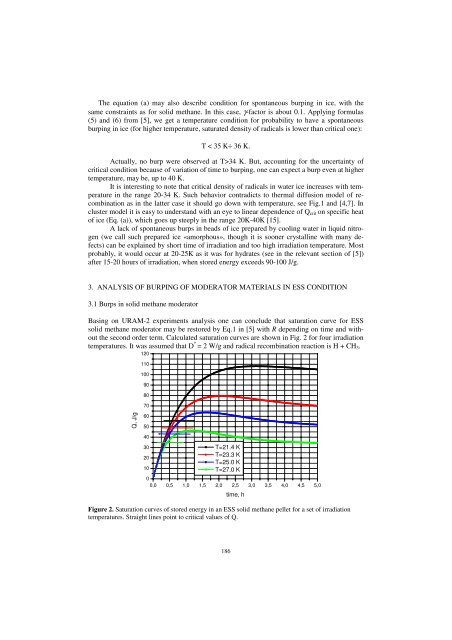Druck-Materie 20b.qxd - JUWEL - Forschungszentrum Jülich
Druck-Materie 20b.qxd - JUWEL - Forschungszentrum Jülich
Druck-Materie 20b.qxd - JUWEL - Forschungszentrum Jülich
Create successful ePaper yourself
Turn your PDF publications into a flip-book with our unique Google optimized e-Paper software.
The equation (a) may also describe condition for spontaneous burping in ice, with the<br />
same constraints as for solid methane. In this case, γ-factor is about 0.1. Applying formulas<br />
(5) and (6) from [5], we get a temperature condition for probability to have a spontaneous<br />
burping in ice (for higher temperature, saturated density of radicals is lower than critical one):<br />
T < 35 K÷ 36 K.<br />
Actually, no burp were observed at T>34 K. But, accounting for the uncertainty of<br />
critical condition because of variation of time to burping, one can expect a burp even at higher<br />
temperature, may be, up to 40 K.<br />
It is interesting to note that critical density of radicals in water ice increases with temperature<br />
in the range 20-34 K. Such behavior contradicts to thermal diffusion model of recombination<br />
as in the latter case it should go down with temperature, see Fig.1 and [4,7]. In<br />
cluster model it is easy to understand with an eye to linear dependence of Qcrit on specific heat<br />
of ice (Eq. (a)), which goes up steeply in the range 20K-40K [15].<br />
A lack of spontaneous burps in beads of ice prepared by cooling water in liquid nitrogen<br />
(we call such prepared ice «amorphous», though it is sooner crystalline with many defects)<br />
can be explained by short time of irradiation and too high irradiation temperature. Most<br />
probably, it would occur at 20-25K as it was for hydrates (see in the relevant section of [5])<br />
after 15-20 hours of irradiation, when stored energy exceeds 90-100 J/g.<br />
3. ANALYSIS OF BURPING OF MODERATOR MATERIALS IN ESS CONDITION<br />
3.1 Burps in solid methane moderator<br />
Basing on URAM-2 experiments analysis one can conclude that saturation curve for ESS<br />
solid methane moderator may be restored by Eq.1 in [5] with R depending on time and without<br />
the second order term. Calculated saturation curves are shown in Fig. 2 for four irradiation<br />
temperatures. It was assumed that D * = 2 W/g and radical recombination reaction is H + CH3.<br />
Q, J/g<br />
120<br />
110<br />
100<br />
90<br />
80<br />
70<br />
60<br />
50<br />
40<br />
30<br />
T=21.4 K<br />
20<br />
T=23.3 K<br />
T=25.0 K<br />
10<br />
0<br />
T=27.0 K<br />
0,0 0,5 1,0 1,5 2,0 2,5 3,0 3,5 4,0 4,5 5,0<br />
186<br />
time, h<br />
Figure 2. Saturation curves of stored energy in an ESS solid methane pellet for a set of irradiation<br />
temperatures. Straight lines point to critical values of Q.

















